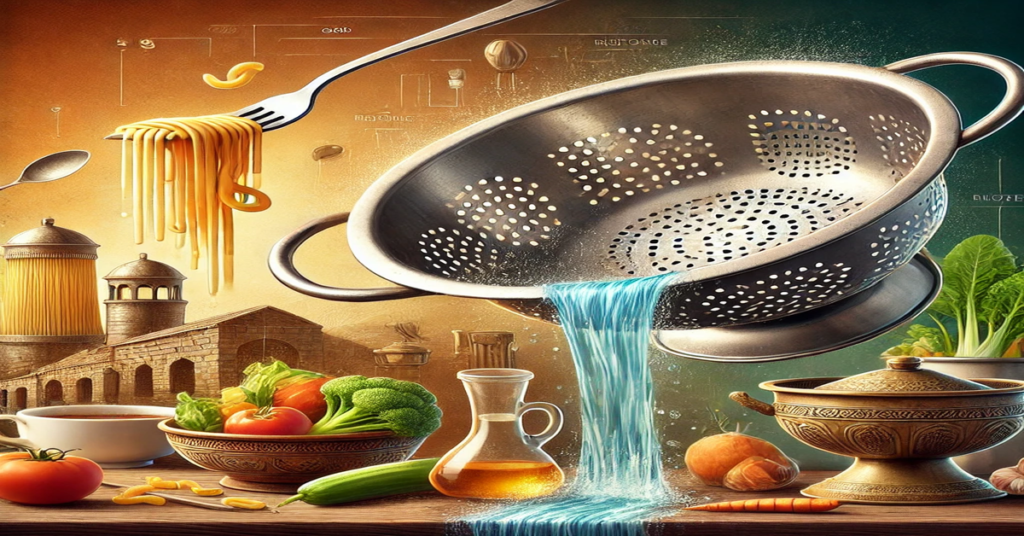The colander, a staple in kitchens around the world, is a versatile and indispensable tool. Known for its perforated structure, this utensil is used primarily to drain liquids from foods such as pasta, vegetables, and rice. But beyond its functional role, the colander has an intriguing history, unique designs, and even cultural significance. This article delves into the origins, various uses, types, and evolving importance of the colander in modern life.
The History of the Colander
1. Ancient Origins
The colander, or strainer, dates back thousands of years. Early examples of perforated kitchen tools were found in ancient Mesopotamia and Egypt. Made from materials such as clay and bronze, these tools were used to separate grains, filter liquids, and prepare food for cooking. These early versions were rudimentary but effective, serving as the precursors to modern colanders.
2. Roman Influence
The ancient Romans popularized the colander’s use in Europe. They created colanders from bronze or other metals, which were highly durable and featured intricate perforations. Romans used them for draining liquids from foods and even for washing fruits and vegetables.
3. Evolution in the Middle Ages
During the Middle Ages, colanders became more common in European households. Made primarily from copper or iron, they were often handcrafted and sometimes served decorative purposes. The craftsmanship of colanders reflected the local traditions and skills of blacksmiths and artisans.
4. Modern Development
With the Industrial Revolution, colanders evolved further. The advent of mass production allowed for the creation of colanders in various shapes, sizes, and materials, including stainless steel, aluminum, and plastic. Today, colanders are ubiquitous in kitchens worldwide, with designs tailored to suit a variety of culinary needs.
Anatomy of a Colander
A typical colander consists of the following components:
- Bowl: The main body, often round, where the food is placed.
- Perforations: Holes or slots that allow liquids to drain while retaining solid food.
- Handles: For easy gripping and maneuvering.
- Base or Feet: Some colanders feature a stable base or feet to allow for hands-free use and efficient draining.
Uses of a Colander
1. Draining Liquids
The primary function of a colander is to drain liquids from foods:
- Pasta: Removing water from cooked pasta is one of the most common uses of a colander.
- Vegetables: Washing and draining leafy greens, fruits, and vegetables is made easier with a colander.
2. Rinsing Foods
A colander is perfect for rinsing grains like rice or lentils, ensuring any excess starch or impurities are washed away.
3. Straining Stocks and Broths
In culinary preparations, colanders can be used to strain large solids from stocks, broths, or soups, separating unwanted elements like bones or herbs.
4. Steaming
Some colanders, particularly those made from heat-resistant materials, can double as steaming baskets when placed over boiling water.
5. Storage and Presentation
In modern kitchens, colanders are sometimes used for serving or presenting food, such as a bowl of freshly washed fruit.
Types of Colanders
1. Metal Colanders
- Material: Typically made from stainless steel, aluminum, or copper.
- Durability: Highly durable and heat-resistant.
- Common Uses: Draining hot liquids, straining stocks, and washing heavy produce.
2. Plastic Colanders
- Material: Lightweight and made from food-grade plastic.
- Advantages: Affordable and available in a variety of colors and sizes.
- Limitations: Less heat-resistant compared to metal colanders.
3. Silicone Colanders
- Material: Flexible and collapsible silicone.
- Advantages: Space-saving design and heat resistance.
- Uses: Ideal for small kitchens or those with limited storage.
4. Mesh Strainers
- Material: Made from fine metal mesh.
- Advantages: Suitable for finer tasks like sifting flour or straining small particles from liquids.
5. Collapsible Colanders
- Design: Foldable structure for easy storage.
- Applications: Great for compact kitchens and travelers.
Care and Maintenance
To prolong the life of your colander, consider the following tips:
- Regular Cleaning: Wash the colander immediately after use to prevent food particles from drying in the perforations.
- Avoid Abrasive Scrubbers: Use non-abrasive cleaning tools to avoid damaging the surface of metal or plastic colanders.
- Dishwasher Safety: Most modern colanders are dishwasher-safe, but always check the manufacturer’s recommendations.
- Storage: Stack colanders carefully or hang them to save space and prevent damage.
Cultural and Symbolic Significance
1. The Colander as a Symbol
In some cultures, colanders represent resourcefulness and practicality. Their association with nourishment and food preparation makes them symbolic of home and family.
2. Colanders in Art and Media
Over time, colanders have appeared in art, advertising, and even popular culture. For instance, their unique shape has been repurposed in quirky ways, such as costumes or decorative objects.
3. Pastafarianism
Interestingly, colanders have gained a humorous cultural significance in the “Church of the Flying Spaghetti Monster,” where followers, known as Pastafarians, use colanders as religious headgear in a satirical take on organized religion.
Innovative Uses of Colanders
Beyond their conventional applications, colanders have found unique uses in various domains:
- Gardening: Used as planters or soil sifters.
- Craft Projects: Repurposed as lampshades or decorative items.
- Outdoor Activities: Ideal for washing or draining items during camping trips.
- Kid-Friendly Activities: Used for sensory play or as a creative base for DIY projects.
The Modern Relevance of Colanders
As culinary trends evolve, so does the relevance of colanders. In modern kitchens, colanders cater to:
- Eco-Friendly Practices: Stainless steel and silicone colanders are sustainable alternatives to disposable strainers.
- Health-Conscious Cooking: Rinsing fruits and vegetables thoroughly to remove pesticides aligns with healthier lifestyles.
- Aesthetic Appeal: Designer colanders with intricate patterns or vibrant colors double as kitchen decor.
Colander Myths and Misconceptions
1. “Colanders Are Only for Pasta”
While draining pasta is a popular use, colanders are versatile tools suitable for a variety of culinary tasks.
2. “Plastic Colanders Are Inferior”
While plastic colanders lack heat resistance, they are lightweight, affordable, and suitable for non-heat-intensive tasks.
3. “All Colanders Are the Same”
Colanders vary significantly in design, material, and purpose. Choosing the right colander depends on your specific needs.
How to Choose the Right Colander
When selecting a colander, consider:
- Material: Choose a material based on durability and heat resistance.
- Size: Opt for a size that suits your typical cooking needs.
- Ease of Cleaning: Look for designs with easy-to-clean perforations.
- Special Features: Collapsible or multi-functional colanders may be ideal for small kitchens or specific uses.
Conclusion
The colander, a humble yet essential kitchen tool, has evolved over centuries to become a symbol of practicality and innovation. From its ancient origins to its modern designs, it continues to play a vital role in food preparation, cultural practices, and even artistic expressions. Whether you’re draining pasta, rinsing fresh produce, or repurposing it creatively, the colander remains a versatile and indispensable tool in every kitchen.
FAQs
1. What is a colander used for?
A colander is used to drain liquids from foods like pasta, rinse vegetables and grains, or strain stocks and broths.
2. What materials are colanders made from?
Colanders are typically made from stainless steel, plastic, silicone, or mesh, each suited for specific tasks and preferences.
3. Can colanders be used for steaming?
Yes, heat-resistant colanders can be used as makeshift steaming baskets when placed over boiling water.
4. Are plastic colanders safe for hot foods?
While plastic colanders are lightweight and affordable, they may not withstand high temperatures and are better for cool or room-temperature tasks.
5. How do I clean a colander?
Colanders can be cleaned with soap and water or in the dishwasher. Avoid abrasive scrubbers to prevent damage.
6. What are some innovative uses for colanders?
Colanders can be repurposed for gardening, craft projects, sensory play, or as decorative lampshades.







